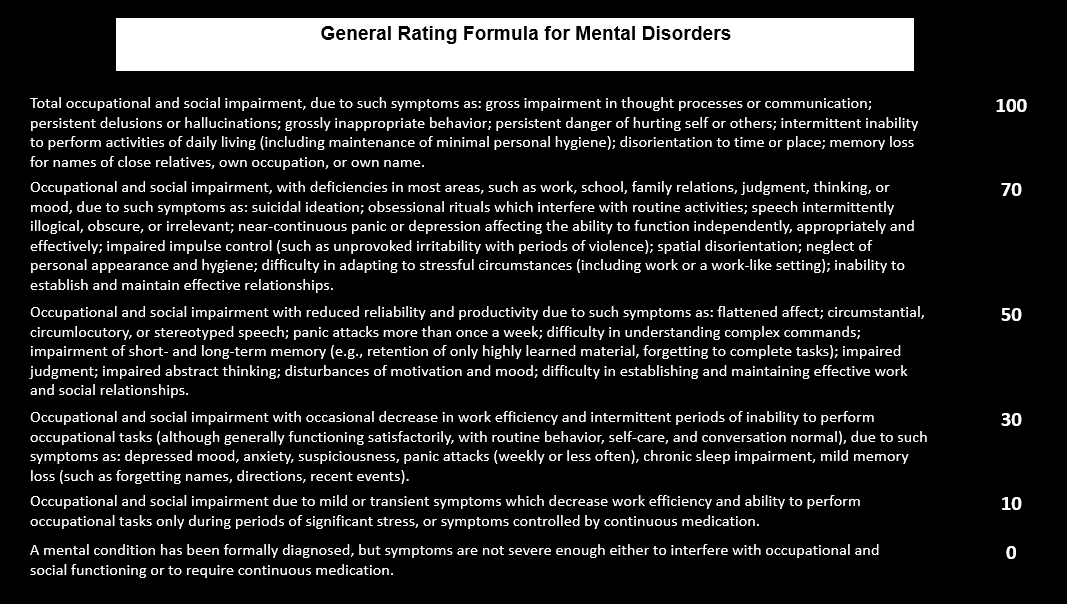Proposals to Reduce
If VA grants a veteran service connection for a disability, it then must assign a rating (or a percentage) for that disability. The rating for a disability is assigned based on the evidence of record. VA reviews the evidence and interprets which rating is appropriate based on a rating schedule. The rating schedule is set forth by the Code of Federal Regulations, and it dictates which signs and symptoms of a disability must be present in order for VA to assign a specific rating.
Under those regulations, the law specifies how VA must use and apply the rating schedule, as well as the goals of the rating schedule. See 38 C.F.R. Part 4; Subpart A: General Policy in Rating, Sections 4.1 to 4.31. The regulations also contain the actual rating schedule and guidance for using particular sections. See 38 C.F.R. Part 4; Subpart B: Disability Ratings, Sections 4.40 to 4.150.
Example:
38 C.F.R. § 4.130 - Schedule of ratings—Mental disorders.
When VA wants to reduce a veteran’s rating, it must follow a particular procedure to do so. First, VA must issue a Proposal to Reduce. This document is only a proposal, meaning it is not a finalized decision. It will typically list the evidence upon which VA based its proposal. A veteran has 30 days from the proposal date to request a predetermination hearing on the matter, which would provide them or their representative a verbal opportunity to refute VA’s proposal. A veteran or their representative has 60 days from the proposal date to submit any additional documentation refuting the proposal, including argumentation against finalizing the proposal.
VA often issues proposals to reduce when a VA examination or other evidence shows improvement in a veteran’s disability. However, the law provides certain protections for veterans whose disabilities meet the following criteria:
If a rating has been in effect for less than 5 years, VA must not reduce unless there is an actual change in the disability based on an entire review of the medical records, and any improvement must be evidenced in both social and occupational aspects of the veteran’s life.
If a rating has been in effect for at least 5 years, the entire medical record must show sustained improvement in order to reduce. This means VA must not reduce based on a single VA exam, but rather only in considering all evidence in the record.
If a rating has been in effect for over 20 years, VA legally cannot reduce except in circumstances where evidence shows fraud in the grant.
VA may also propose to reduce a veteran’s rating based on removing their grant of a total disability rating based on Individual Unemployability (also known as TDIU). In these cases, the totality of circumstances, including current service connected disability symptoms and employment status, must show that a total rating is not warranted. A return to profitable work (i.e. gainful employment with earnings in excess of the federal poverty threshold) with no special accommodations would suffice to terminate TDIU. However, the work must also be sustained for a period of 12 months or more.
Following VA’s proposal, VA will issue a final rating decision either maintaining the veteran’s current rating or finalizing the proposed reduction. The rating decision will specify which new rating VA has assigned, based on their interpretation of the evidence, as well as the effective date of this new rating.
Veterans have the right to appeal finalized rating decisions if they disagree with the reduction. They may submit the following appeal forms within one (1) year of the rating decision:
VA Form 20-0996, Decision Review Request: Higher-Level Review;
VA Form 20-0995, Decision Review Request: Supplemental Claim; or
VA Form 10182, Decision Review Request: Board Appeal (Notice of Disagreement)


